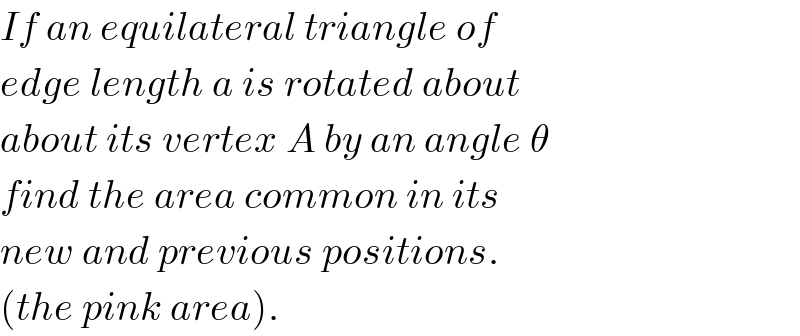
Question and Answers Forum
Question Number 27771 by ajfour last updated on 14/Jan/18

Commented by ajfour last updated on 14/Jan/18

Answered by mrW2 last updated on 14/Jan/18

Commented by mrW2 last updated on 14/Jan/18
![2α+θ=(π/3) ⇒α=(π/6)−(θ/2) ((BP)/(sin θ))=((AB)/(sin (π−(π/3)−θ)))=(a/(sin ((π/3)+θ))) ⇒BP=((sin θ)/(sin ((π/3)+θ)))×a similarly ((CM)/(sin α))=(a/(sin ((π/3)+α))) ⇒CM=((sin α)/(sin ((π/3)+α)))×a=((sin ((π/6)−(θ/2)))/(sin ((π/2)−(θ/2))))×a=((sin ((π/6)−(θ/2)))/(cos (θ/2)))×a PM=a−((sin θ)/(sin ((π/3)+θ)))×a−((sin ((π/6)−(θ/2)))/(cos (θ/2)))×a =a[1−((sin θ)/(((√3)/2) cos θ+(1/2) sin θ))−(((1/2) cos (θ/2)−((√3)/2) sin (θ/2))/(cos (θ/2)))] =a[(1/2)−((2 tan θ)/((√3)+tan θ))+((√3)/2) tan (θ/2)] A_(ΔAPM) =(1/2)×PM×(((√3) a)/2)=(((√3) a^2 )/4)[(1/2)−((2 tan θ)/((√3)+tan θ))+((√3)/2) tan (θ/2)] ⇒A_(APMQ) =2A_(ΔAPM) =(((√3) a^2 )/4)[1−((4 tan θ)/((√3)+tan θ))+(√3) tan (θ/2)]](Q27777.png)
Commented by ajfour last updated on 15/Jan/18

Commented by mrW2 last updated on 16/Jan/18

Answered by ajfour last updated on 14/Jan/18

Commented by ajfour last updated on 14/Jan/18
![eq. of BP : y=−(√3)(x−a) eq. of AP : y=xtan θ eq. of AM : y=xtan (θ+α) =xtan ((π/6)+(θ/2)) y_P =−(√3)(x_P −a)=x_P tan θ ⇒ y_P =((a(√3)tan θ)/((√3)+tan θ)) similarly y_M =((a(√3)tan ((π/6)+(θ/2)))/((√3)+tan ((π/6)+(θ/2)))) =((a(√3))/((√3)(((1−((tan (θ/2))/(√3)))/((1/(√3))+tan (θ/2))))+1)) =((a(√3))/((√3)[(((√3)−tan (θ/2))/(1+(√3)tan (θ/2)))]+1)) =((a(√3)[1+(√3)tan (θ/2)])/4) reqd. area=2×(a/2)(y_M −y_P ) =((a^2 (√3))/4)[1+(√3)tan (θ/2)−((4tan θ)/((√3)+tan θ))] .](Q27783.png)
